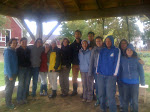So I'm trying a new format--jamming it all in on one post for the week. At the end are beautiful photographs that round out the work experience into this wonderful life experience!
 |
| Walkways at First Root |
On Monday morning, we jumped into the van and headed for Boston. We had a morning meeting with Chef Peter of Henrietta's Table in the Charles Hotel in Cambridge. The focus of our chat was for us to hear how farmers connect with a chef. His method is to meet with farmers in the winter to plan what he would like to buy. This helps the farmer to plan his plantings.
 |
| Washing tables at the perfect height! |
In the afternoon, we visited First Root Farm in Concord MA. This was an inspiring visit as the farmers, Ariel and Laura, are graduates of this very program! They are in their second season of their CSA and it was exciting to hear their plantings, how they are creating and connecting with their community, how they are figuring out their business. The land they are farming is part of the Battle Road Farms which is a collection of farms on the Minuteman National Historic Park. Check out their beautiful blog:
firstrootfarm.com

On Tuesday, it was the first of our glorious potato planting day.
On Wednesday, we spent the morning learning about tillage and cultivation tools and techniques.
 |
| wheel cultivator |
 |
| Attachments for the Cubbies |
 |
| Patrick shows us the BCS |
 |
| the site for my first official weld |
On Wednesday afternoon, I had the opportunity (thanks team!) to work on welding all by myself. With Josh's supervision... I practiced with a chunk of steel--getting the arc just right, moving slowly enough to melt the weld into the two pieces to be joined, and moving quickly enough not to leave huge blobs... I practiced and practiced and didn't set myself on fire. So I had the opportunity to weld a bit of Olivier's animal trailer. I snapped a before shot but didn't get the "after" shot--hopefully I'll be able to get one.
Thursday was a remay-in-the-fields, clear-the-hedgerows and weed-the-pea-plants sort of day. Highlights included Kiyoshi swinging from a vine a la Tarzan and the visit from Henry, the enthusiastic beagle during our weeding.
 |
| wild flower: trillium |
 |
| wild fungus: blue green something |
 |
| wild fun guy: Kiyoshi on the vine |
 |
| insects mating on pea plant |
 |
| "Stitch in the ditch" |
 |
| Fermenting nettle "tea" for foliar feeding |
Friday:
 |
| Wood in new piles |
This morning our group sorted the lumber at the sawmill, moving it to a temporary location so we can erect our saw mill timber frame shed soon. We sorted wood by thickness, "wain-i-ness", soft wood and hard wood.
 |
| Saw mill ready for timber frame |
We then tidied up around the bread oven work site and learned how to get a truck out of a gravel pit.
 |
| Bread oven work site |
In the afternoon, we worked with Olivier on fencing. In particular, we learned how to run the string-trimmer or weed-whacker and then cleaned up fence areas and generally tended to the animal fencing situation.
 |
| Line trimming set up |
 |
| Caitlin and Emma rewiring the Triangle Field fence |
And there were some glorious creatures to see out in Waslaske Fields:
 |
| Site of a turkey nest |
 |
| Wild turkey eggs |
 |
| Small, speckled eggs |
 |
| Tiny green bee |
 |
| Grasshopper! |
Other Fun Photos for the week:
 |
| Curious Chase Hill calves |
 |
| Our piglets, tessellating |
 |
| Free-range bicycles in their portable coop for the night |
 |
| See! Broccoli can be fun food! (snipped from my daughter's blog) |


 Jen came to help us "install" our bee packages. One can buy a package of bees with a queen to put into an empty hive. We ordered 5 packages of bees--two of them arrived in good condition and other three arrived nearly dead. Jen decided that the three packages in rough condition would be joined together.
Jen came to help us "install" our bee packages. One can buy a package of bees with a queen to put into an empty hive. We ordered 5 packages of bees--two of them arrived in good condition and other three arrived nearly dead. Jen decided that the three packages in rough condition would be joined together.



















































